Lithium-ion Battery Recycling Market
Lithium-ion Battery Recycling Market Size and Share Forecast Outlook 2025 to 2035
Lithium-ion battery recycling market is projected to grow from USD 0.3 billion in 2025 to USD 12.0 billion by 2035, at a CAGR of 45.1%. Transportation will dominate with a 69.8% market share, while asia pacific will lead the region segment with a 33.1% share.
Lithium-ion Battery Recycling Market Forecast and Outlook 2025 to 2035
The global lithium-ion battery recycling market is projected to reach USD 11.96 billion by 2035, recording an absolute increase of USD 11.67 billion over the forecast period. The market is valued at USD 0.29 billion in 2025 and is set to rise at a CAGR of 45.1% during the assessment period.
Quick Stats for Lithium-ion Battery Recycling Market
- Lithium-ion Battery Recycling Market Value (2025): USD 0.29 billion
- Lithium-ion Battery Recycling Market Forecast Value (2035): USD 11.96 billion
- Lithium-ion Battery Recycling Market Forecast CAGR: 45.1%
- Leading Application in Lithium-ion Battery Recycling Market: Transportation (69.8%)
- Key Growth Regions in Lithium-ion Battery Recycling Market: Asia Pacific, North America, and Europe
- Top Players in Lithium-ion Battery Recycling Market: Contemporary Amperex Technology Co., Limited (CATL), LG Energy Solution, Panasonic Corporation, Samsung SDI Co., Ltd., BYD, SVOLT Energy, Tesla, Shenzhen Manly Battery Co., Toshiba Corporation, SK on Co., Ltd, CALB, Gotion, Inc., Sunwoda Electronic Co. Ltd, Li-Cycle Corp., Helbiz
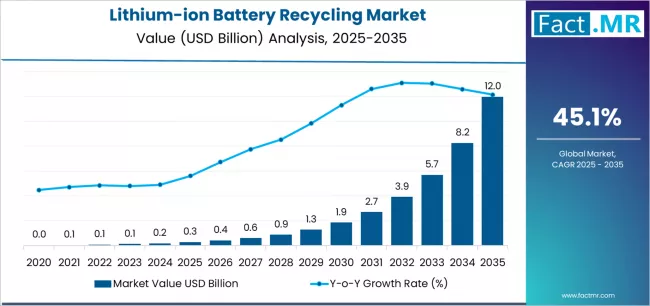
The overall market size is expected to grow by approximately 41.6 times during the same period, supported by increasing electric vehicle adoption and expanding battery waste generation across transportation sectors worldwide, driving demand for sustainable resource recovery solutions and increasing investments in advanced recycling technologies with critical material extraction capabilities across lithium, cobalt, nickel, and manganese recovery applications globally.
Battery manufacturers face mounting pressure to secure sustainable raw material supplies while addressing environmental regulations and circular economy mandates, with modern lithium-ion battery recycling operations providing documented recovery benefits including high extraction efficiency, reduced mining dependence, and lower carbon footprint compared to primary material production alone.
Rising emphasis on critical mineral security and expanding extended producer responsibility programs enabling closed-loop battery value chains create substantial opportunities for recycling operators and automotive manufacturers. However, collection infrastructure gaps and technology standardization challenges may pose obstacles to achieving comprehensive recycling rates and economic viability.
The transportation application segment dominates market activity, driven by explosive growth in electric vehicle deployments and corresponding end-of-life battery volumes requiring systematic collection and processing across automotive sectors worldwide. Industries increasingly recognize the economic value of spent EV batteries, with typical recycling operations providing efficient material recovery and secondary raw material production at competitive costs through established hydrometallurgical and pyrometallurgical processes.
The transportation segment demonstrates the strongest market presence, supported by regulatory mandates for battery producer responsibility and automotive industry commitments to circular economy principles driving comprehensive recycling infrastructure development. China represents the fastest-growing market, driven by world-leading electric vehicle production volumes and government-mandated battery recycling programs supporting closed-loop supply chains.
Regional dynamics show Asia Pacific maintaining market leadership, supported by concentrated battery manufacturing capacity and stringent recycling regulations driving systematic collection and processing infrastructure across producing nations. USA demonstrates robust growth potential driven by Inflation Reduction Act incentives and domestic battery supply chain development requiring critical mineral recovery, while Europe emphasizes circular economy principles and comprehensive battery regulations.
Germany leads European expansion through advanced automotive sector integration and established recycling infrastructure, followed by Japan supported by mature electronics recycling systems and technological expertise.
The competitive landscape features moderate concentration with Contemporary Amperex Technology Co., Limited (CATL) maintaining market leadership position at a 17.5% market share, while established players including LG Energy Solution, Panasonic Corporation, Samsung SDI, and BYD compete through vertical integration strategies and comprehensive recycling capabilities across diverse battery chemistries.
Lithium-ion Battery Recycling Market Year-over-Year Forecast 2025 to 2035
Between 2025 and 2029, the lithium-ion battery recycling market is projected to expand from USD 0.29 billion to USD 1.27 billion, resulting in a value increase of USD 0.98 billion, which represents 8.4% of the total forecast growth for the period. This phase of development will be shaped by rising volumes of end-of-life electric vehicle batteries reaching recycling streams, technology innovation in direct recycling and hydrometallurgical processes with enhanced recovery efficiency and reduced environmental impact, as well as expanding regulatory frameworks mandating extended producer responsibility and minimum recycled content requirements. Companies are establishing competitive positions through investment in automated disassembly systems, advanced separation technologies, and strategic partnerships across automotive manufacturers, battery producers, and collection network operators.
From 2029 to 2035, the market is forecast to grow from USD 1.27 billion to USD 11.96 billion, adding another USD 10.69 billion, which constitutes 91.6% of the overall expansion. This period is expected to be characterized by the expansion of commercial-scale recycling facilities, including gigafactory-integrated operations and regional processing hubs tailored for specific battery chemistries and application requirements, strategic collaborations between automotive OEMs and recycling specialists, and an enhanced focus on direct recycling technologies preserving cathode materials and battery-grade quality specifications. The growing emphasis on domestic critical mineral supply chains and rising adoption of circular economy business models will drive demand for comprehensive recycling solutions with high recovery rates across lithium, nickel, cobalt, manganese, and graphite materials supporting sustainable battery manufacturing.
Lithium-ion Battery Recycling Market Key Takeaways
| Metric | Value |
|---|---|
| Market Value (2025) | USD 0.29 billion |
| Market Forecast Value (2035) | USD 11.96 billion |
| Forecast CAGR (2025-2035) | 45.1% |
Why is the Lithium-ion Battery Recycling Market Growing?
The lithium-ion battery recycling market grows by enabling battery manufacturers and automotive producers to secure critical raw material supplies and achieve circular economy objectives while addressing resource scarcity and environmental regulations without excessive dependence on primary mining operations and geopolitically concentrated supply chains.
Battery producers face mounting pressure to reduce carbon footprint and ensure sustainable sourcing while meeting increasing demand for electric vehicles and energy storage systems, with modern recycling operations typically providing essential material recovery including lithium carbonate, cobalt sulfate, nickel sulfate, and manganese compounds compared to virgin material extraction alone, making comprehensive recycling infrastructure essential for sustainable battery value chains.
The automotive industry's need for secure and cost-competitive critical minerals creates demand for specialized recycling solutions that can provide high recovery rates, battery-grade material quality, and economic viability without compromising environmental performance or regulatory compliance.
Regulatory mandates and corporate sustainability commitments drive adoption in automotive environments, battery manufacturing operations, and energy storage facilities, where material circularity has direct impact on supply chain resilience and environmental footprint. The increasing volumes of end-of-life batteries from first-generation electric vehicles, affecting automotive markets and consumer electronics sectors globally, create expanding material flows requiring systematic collection and processing infrastructure.
Rising awareness about critical mineral security and supply chain risks enables informed investment decisions and adoption of vertically integrated recycling capabilities. However, economic viability challenges at current battery volumes and technical complexity across diverse battery chemistries may limit recycling rates among certain applications with different collection logistics or material value propositions.
Segmental Analysis
The market is segmented by application and region. By application, the market is divided into transportation, consumer electronics, and industrial. Regionally, the market is divided into Asia Pacific, Europe, North America, Latin America, and MEA.
By Application, Which Segment Accounts for the Dominant Market Share?
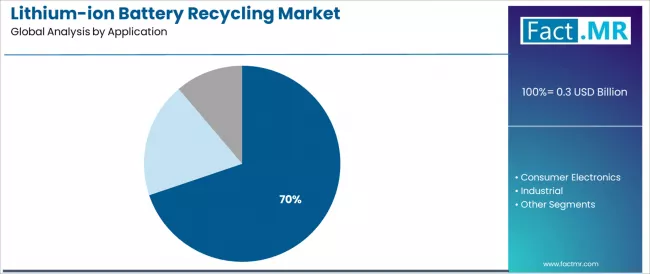
The transportation application segment represents the dominant force in the lithium-ion battery recycling market, capturing 69.8% of the total market share in 2025. This established application category encompasses solutions addressing end-of-life electric vehicle batteries and hybrid vehicle battery packs, including advanced processing systems handling diverse cell formats and battery chemistries that enable efficient material recovery and secondary raw material production across automotive recycling operations worldwide.
The transportation segment's market leadership stems from its massive volume potential, with solutions capable of processing large-format battery packs containing substantial quantities of valuable materials including lithium, cobalt, nickel, and manganese while addressing regulatory compliance requirements and automotive industry circularity commitments across global electric vehicle markets.
The consumer electronics segment maintains a substantial market share at 17.0%, serving established recycling streams from smartphones, laptops, power tools, and portable devices requiring systematic collection and processing for material recovery.
These applications offer proven recycling economics for accessible material flows while providing sufficient infrastructure to support ongoing collection programs. The consumer electronics segment demonstrates steady baseline demand, driven by continuous product replacement cycles and mature collection systems in developed markets.
Within the application category, industrial applications including energy storage systems and stationary battery installations demonstrate emerging adoption, driven by growing deployments of grid-scale battery systems and upcoming end-of-life volumes from utility and commercial storage projects. This sub-segment benefits from predictable retirement schedules and centralized collection opportunities.
Key market advantages driving the transportation segment include:
- Massive volume growth potential with exponential increase in end-of-life EV batteries creating substantial material availability for recycling operations over forecast period
- High material value concentrations allowing favorable processing economics and attractive return on investment for dedicated recycling infrastructure development
- Regulatory support mechanisms including extended producer responsibility mandates and recycled content requirements driving systematic collection and processing
- Automotive industry commitments providing strategic partnerships and long-term supply agreements supporting recycling facility investment and capacity expansion
By Region, Which Segment Accounts for the Largest Market Share?
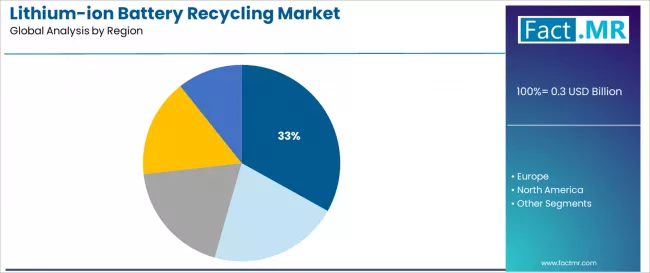
Asia Pacific dominates the lithium-ion battery recycling regional landscape with substantial market share reflecting the critical concentration of global battery manufacturing capacity and electric vehicle production driving comprehensive recycling infrastructure development across producing nations. A market share of 33.1% is projected for the Asia Pacific market.
The Asia Pacific region's market leadership is reinforced by government-mandated recycling programs, integrated battery value chains, and massive electric vehicle deployment volumes that generate significant end-of-life battery streams requiring systematic processing capabilities.
Within this region, China represents the overwhelming driver of recycling market growth, supported by world-leading electric vehicle sales, comprehensive battery producer responsibility regulations, and extensive recycling capacity investments. This sub-segment benefits from integrated battery manufacturing ecosystems and closed-loop supply chain initiatives by major automotive and battery producers.
The North America segment represents an important regional category with explosive growth potential, demonstrating rapid expansion through Inflation Reduction Act incentives, domestic battery manufacturing investments, and critical mineral security priorities. This region benefits from substantial federal funding support and automotive industry commitments to localized supply chains.
The Europe region maintains significant presence through stringent circular economy regulations and comprehensive battery legislation requiring minimum collection rates and recycled content targets, while Latin America and MEA serve emerging electric vehicle markets with developing recycling infrastructure.
Key market dynamics supporting regional segment growth include:
- Asia Pacific expansion driven by massive EV production volumes and government recycling mandates, requiring substantial processing capacity and collection infrastructure
- North America category growth requiring critical mineral security and domestic supply chain development for battery materials
- Integration of extended producer responsibility frameworks enabling systematic collection and automotive industry participation
- Growing emphasis on technology leadership driving investment in advanced recycling processes and high-efficiency recovery systems
What are the Drivers, Restraints, and Key Trends of the Lithium-ion Battery Recycling Market?
The market is driven by three concrete demand factors tied to sustainable resource outcomes. First, exponential growth in electric vehicle adoption and corresponding battery retirement volumes create massive material streams requiring systematic recycling infrastructure, with end-of-life battery processing representing an essential component of circular battery value chains in automotive sectors, requiring widespread facility deployment. Second, critical mineral supply security concerns and geopolitical concentration risks drive automotive and battery manufacturers toward vertical integration and domestic recycling capacity, with recovered materials demonstrating significant advantages in supply chain resilience, price stability, and environmental footprint reduction through closed-loop systems by 2030. Third, strengthening regulatory frameworks including extended producer responsibility mandates and minimum recycled content requirements enable comprehensive collection systems that improve material recovery while supporting environmental objectives and circular economy transitions.
Market restraints include economic viability challenges at current battery volumes and processing scale that can limit profitability and investment returns, particularly for pioneer facilities where capital costs prove substantial and feedstock availability remains limited during market development phases. Technology standardization gaps across diverse battery chemistries and cell formats pose another significant obstacle, as recycling operations require flexible processing capabilities addressing NMC, LFP, NCA, and emerging battery technologies, potentially affecting processing efficiency and recovery economics. Collection infrastructure limitations and logistics complexity create additional barriers for achieving high recovery rates, demanding comprehensive reverse logistics networks and coordination across automotive dealers, dismantlers, and recycling facilities.
Key trends indicate accelerated direct recycling technology development in advanced markets, particularly North America and Europe, where companies and research institutions demonstrate growing focus on cathode regeneration processes offering superior energy efficiency, reduced chemical consumption, and preserved material quality compared to conventional pyrometallurgical and hydrometallurgical approaches. Vertical integration trends toward automotive OEM-owned recycling facilities with captive material supply arrangements enable strategic control over critical minerals and guaranteed feedstock access for battery manufacturing operations. However, the market thesis could face disruption if significant advances in battery longevity or major shifts in battery chemistry composition reduce material values and recycling economics fundamentals.
Analysis of the Lithium-ion Battery Recycling Market by Key Countries
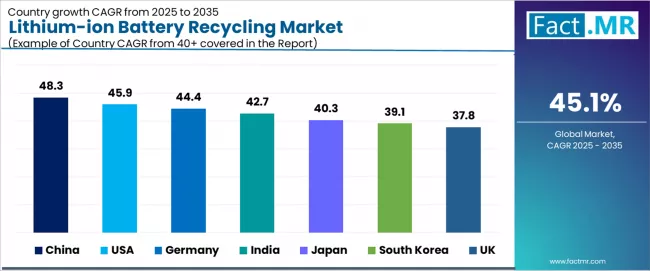
| Country | CAGR (2025-2035) |
|---|---|
| China | 48.3% |
| USA | 45.9% |
| Germany | 44.4% |
| India | 42.7% |
| Japan | 40.3% |
| South Korea | 39.1% |
| UK | 37.8% |
The global lithium-ion battery recycling market is expanding explosively, with China leading at a 48.3% CAGR through 2035, driven by largest EV battery recycling volume and government mandate supporting comprehensive producer responsibility programs. USA follows at 45.9%, supported by federal incentives and IRA battery policy promoting domestic critical mineral supply chains.
Germany records 44.4%, reflecting strong recycling infrastructure and automotive base implementing circular economy principles. India advances at 42.7%, leveraging fast EV adoption and urban mineral recovery programs. Japan posts 40.3%, focusing on mature electronics and EV ecosystem with established recycling expertise, while South Korea grows robustly at 39.1%, emphasizing rapid innovation in battery chemistry and processing technologies. UK demonstrates 37.8% growth, anchored by circular economy regulatory pressure and automotive industry transition.
How is China Leading Global Market Expansion?
China demonstrates the strongest growth potential in the lithium-ion battery recycling market with a CAGR of 48.3% through 2035. The country's leadership position stems from world-leading electric vehicle production and sales volumes, comprehensive government regulations mandating battery producer responsibility, and extensive investments in recycling infrastructure by major battery manufacturers including CATL, BYD, and integrated automotive companies driving systematic material recovery across battery value chains.
Growth is concentrated in major battery production clusters and EV manufacturing hubs, including Jiangsu, Guangdong, Fujian, and Hunan, where recycling facilities are increasingly processing end-of-life batteries for secondary raw material production beyond export-dependent primary mining.
Collection channels through automotive dealers, battery swap stations, and dedicated reverse logistics networks expand battery recovery rates across urban centers and EV deployment regions. The country's comprehensive battery traceability systems and circular economy policies provide strong momentum for closed-loop battery ecosystems, including mandatory adoption across automotive manufacturers and battery producers seeking regulatory compliance and material supply security.
Key market factors:
- Electric vehicle deployment concentrated in tier-1 and tier-2 cities with extensive battery retirement volumes supporting recycling economics
- Recycling capacity expansion through integrated battery manufacturers and specialized processing companies establishing commercial-scale facilities
- Comprehensive regulatory framework, including producer responsibility extension and battery traceability systems with proven enforcement mechanisms
- Domestic battery manufacturing leadership featuring companies integrating recycling operations into vertical supply chains addressing material security
Why is USA Emerging as a Critical Growth Market?
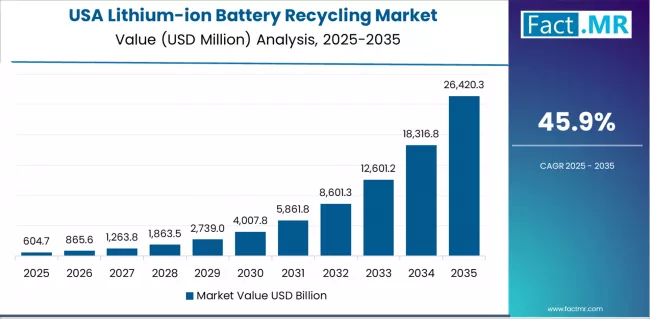
In major automotive production regions including Michigan, California, Texas, and Tennessee, the development of lithium-ion battery recycling infrastructure is accelerating across battery manufacturing hubs, driven by Inflation Reduction Act incentives and federal emphasis on domestic critical mineral supply chains. The market demonstrates explosive growth momentum with a CAGR of 45.9% through 2035, linked to comprehensive battery manufacturing investments and increasing policy support for circular economy development.
American companies are implementing advanced recycling technologies integrated with domestic battery production to secure material supply while meeting requirements for domestic content and recycled material utilization. The country's expanding electric vehicle adoption and upcoming end-of-life battery volumes create substantial feedstock availability for recycling operations, while increasing emphasis on supply chain resilience drives automotive and battery manufacturer investments in captive recycling capacity.
Key development areas:
- Automotive manufacturers and battery producers leading recycling capacity investments with emphasis on vertical integration and material security
- Technology development enabling direct recycling and advanced hydrometallurgical processes for high-efficiency recovery
- Federal policy support including IRA battery manufacturing credits and critical minerals initiatives incentivizing domestic recycling
- Strategic partnerships between automotive OEMs and specialized recycling companies expanding collection networks and processing capabilities
What drives Germany’s Market Automotive Integration?
Germany’s market expansion is driven by automotive industry leadership, including comprehensive sustainability commitments from major OEMs and established recycling infrastructure supporting systematic battery collection and processing. The country demonstrates substantial growth potential with a CAGR of 44.4% through 2035, supported by stringent EU battery regulations and circular economy principles embedded in automotive manufacturing strategies.
German facilities face implementation requirements related to minimum collection rates and recycled content targets, necessitating comprehensive reverse logistics development and processing capacity investments. However, established automotive engineering expertise and advanced manufacturing capabilities create favorable conditions for recycling technology development and deployment, particularly among facilities pursuing regulatory compliance where material circularity drives strategic positioning and competitive advantages.
Market characteristics:
- Automotive sector facilities showing robust recycling integration with substantial capacity development across Baden-Württemberg and Bavaria
- Regional expertise concentrating on advanced processing technologies and high-purity material recovery for battery-grade applications
- Future projections indicate continued vertical integration with emphasis on OEM-controlled recycling operations and material supply security
- Growing emphasis on direct recycling development and cathode regeneration technologies supporting premium battery manufacturing
How does India Demonstrate Urban Mining Leadership?
The market for lithium-ion battery recycling in India positions for substantial growth in battery recycling based on rapid electric vehicle adoption trajectories and government programs promoting urban mineral recovery and circular economy development. The country shows strong potential with a CAGR of 42.7% through 2035, driven by two-wheeler and three-wheeler electrification initiatives and emerging battery manufacturing capacity in major industrial regions, including Maharashtra, Tamil Nadu, Gujarat, and Karnataka.
Indian companies are developing recycling capabilities through technology partnerships and capacity investments for comprehensive material recovery, particularly in growing EV markets and electronics recycling operations demanding systematic collection infrastructure. Collection channels through automotive dealers and battery swap networks expand battery recovery rates across urban deployment regions and commercial vehicle operations.
Leading market segments:
- Two-wheeler and three-wheeler battery recycling in major cities implementing electric mobility programs
- Manufacturing capacity development including domestic recycling facilities and international technology collaborations
- Strategic government initiatives including battery swapping standards and extended producer responsibility frameworks
- Focus on informal sector formalization addressing unorganized recycling activities and environmental compliance
What Positions Japan for Technology Excellence Leadership?
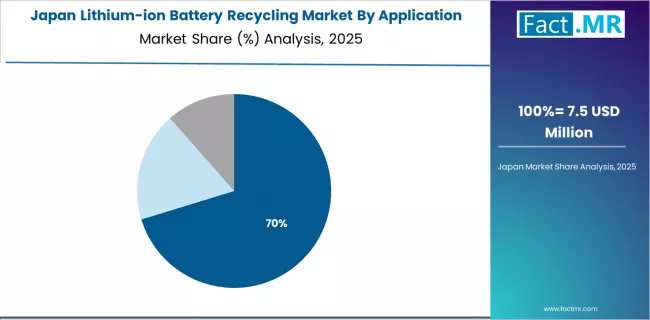
In major industrial regions including Kanto, Chubu, and Kinki, companies are implementing lithium-ion battery recycling through advanced processing technologies and comprehensive quality management systems, with documented case studies showing substantial material recovery rates through sophisticated hydrometallurgical and direct recycling processes developed by integrated electronics and automotive manufacturers.
The market shows solid growth potential with a CAGR of 40.3% through 2035, linked to established electronics recycling infrastructure, automotive sector transition to electrification, and technological innovation in material separation and purification processes. Companies are adopting high-efficiency recycling systems with precise recovery protocols to maximize material value while maintaining standards demanded by quality-focused battery manufacturing environments. The country's established battery technology expertise and automotive manufacturing excellence create ongoing opportunities for recycling innovations that differentiate through technical sophistication and material quality optimization.
Market development factors:
- Electronics and automotive companies leading adoption of integrated recycling operations across Japan
- Technology leadership providing competitive advantages in processing efficiency and material purity specifications
- Strategic collaborations between battery manufacturers and recycling specialists expanding closed-loop material flows
- Emphasis on automation and robotics integration addressing labor constraints and processing consistency requirements
How does South Korea Show Innovation Leadership?
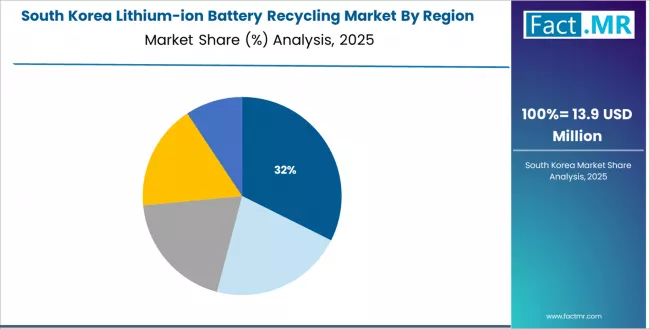
South Korea's lithium-ion battery recycling market demonstrates rapid technology development focused on advanced battery chemistries and next-generation processing methods, with documented integration of innovative separation techniques achieving superior recovery economics in pilot and commercial operations across battery manufacturing clusters.
The country maintains strong growth momentum with a CAGR of 39.1% through 2035, driven by leading battery manufacturer presence and comprehensive R&D investments emphasizing processing innovation methodologies that align with competitive positioning requirements applied to Korean battery industry leadership. Major battery production regions, including Chungcheong, Gyeonggi, and Ulsan, showcase expanding recycling capacity where material recovery integrates seamlessly with gigafactory operations and comprehensive battery value chain strategies.
Key market characteristics:
- Battery manufacturer leadership including LG Energy Solution, Samsung SDI, and SK on driving vertical integration strategies
- Innovation emphasis enabling advanced processing technologies and battery chemistry-specific recycling approaches
- Technology partnerships between Korean companies and international recycling specialists expanding capabilities and market access
- Focus on high-nickel battery chemistries addressing premium material recovery and cathode regeneration opportunities
What Characterizes UK's Regulatory-Driven Development?
In major automotive regions including West Midlands, North West England, and Scotland, the development of lithium-ion battery recycling capabilities serves growing electric vehicle deployment and regulatory compliance requirements, driven by circular economy policies and automotive industry transition programs.
The market demonstrates solid growth potential with a CAGR of 37.8% through 2035, linked to comprehensive battery legislation and extended producer responsibility frameworks supporting collection infrastructure and processing capacity investments.
Companies are implementing recycling solutions capable of addressing diverse battery formats to support material recovery while meeting operational expectations in regulated environments and automotive supply chains. The country's automotive industry restructuring and battery manufacturing investments create ongoing demand for integrated recycling capabilities, while increasing emphasis on domestic value chains drives development of regional processing infrastructure.
Key development areas:
- Automotive sector transformation leading battery recycling infrastructure development with emphasis on supply chain localization
- Regulatory frameworks including producer responsibility and collection targets driving systematic implementation
- Investment programs supporting recycling facility development and technology demonstration projects
- Integration of academic research institutions collaborating with industry on advanced recycling technology development
Europe Market Split by Country
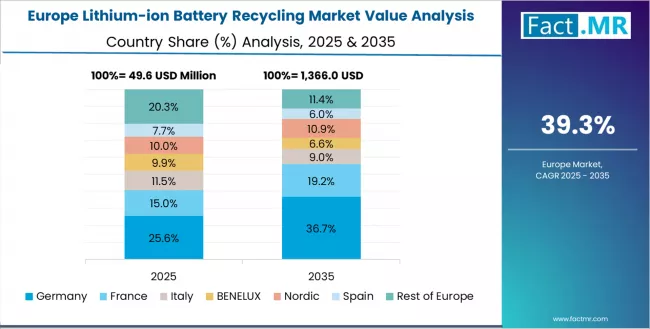
The lithium-ion battery recycling market in Europe is projected to grow from USD 71.2 million in 2025 to USD 3,104.8 million by 2035, registering a CAGR of 43.8% over the forecast period. Germany is expected to maintain its leadership position with a 31.5% market share in 2025, adjusting to 32.8% by 2035, supported by its extensive automotive manufacturing base, advanced recycling technology development, and comprehensive battery value chain integration serving major European electric vehicle markets.
France follows with a 20.3% share in 2025, projected to reach 19.7% by 2035, driven by automotive industry presence and government support for domestic battery manufacturing and recycling capacity in major industrial regions implementing circular economy strategies. UK holds a 17.8% share in 2025, expected to maintain 17.4% by 2035 through ongoing automotive sector transition and battery gigafactory developments.
Italy commands a 13.4% share, while Spain accounts for 10.2% in 2025. The Rest of Europe region is anticipated to gain momentum, expanding its collective share from 6.8% to 7.9% by 2035, attributed to increasing battery recycling adoption in Nordic countries and emerging Eastern European automotive manufacturing sites implementing extended producer responsibility programs.
Competitive Landscape of the Lithium-ion Battery Recycling Market
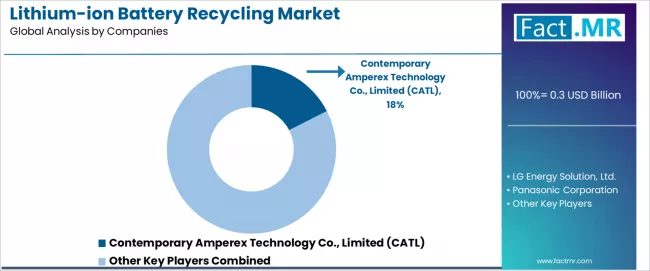
The lithium-ion battery recycling market features approximately 30-40 meaningful players with moderate concentration, where the top three companies control roughly 35-45% of global market share through vertical integration strategies, established processing capabilities, and comprehensive automotive partnerships. Competition centers on processing technology, material recovery efficiency, and supply chain integration rather than volume competition alone.
Market leaders include Contemporary Amperex Technology Co., Limited (CATL) maintaining a 17.5% market share, LG Energy Solution, and Panasonic Corporation, which maintain competitive advantages through vertical integration spanning battery manufacturing through recycling operations, comprehensive processing capabilities addressing diverse battery chemistries, and strategic automotive partnerships securing long-term feedstock supply, creating stable material flows among battery producers seeking closed-loop supply chains. These companies leverage manufacturing scale and ongoing technology development to defend market positions while expanding recycling capacity aligned with battery production growth and automotive industry commitments.
Challengers encompass established battery manufacturers including Samsung SDI Co., Ltd., BYD, and SVOLT Energy, which compete through integrated business models and captive recycling capacity supporting battery production requirements. Automotive companies, including Tesla, and specialized recycling operators including Li-Cycle Corp., focus on specific processing technologies or regional markets, offering differentiated capabilities in hydrometallurgical processing, direct recycling methods, and hub-and-spoke collection models.
Emerging technology specialists and regional recycling companies create competitive pressure through innovative processing approaches and localized infrastructure advantages, particularly in regions including North America and Europe, where regulatory support and domestic supply chain priorities provide market entry opportunities.
Market dynamics favor companies that combine reliable feedstock access with efficient processing technology that addresses diverse customer requirements from battery manufacturers through automotive OEMs and material traders.
Strategic emphasis on direct recycling technology development, automated disassembly systems, and battery-grade material production enables differentiation in increasingly technology-driven and regulation-intensive lithium-ion battery recycling market segments across transportation and industrial applications.
Global Lithium-ion Battery Recycling Market — Stakeholder Contribution Framework
Lithium-ion battery recycling represents a critical circular economy enabler that allows battery manufacturers and automotive producers to secure sustainable raw material supplies and achieve environmental objectives while addressing resource scarcity and supply chain risks without excessive dependence on primary mining operations and geopolitically concentrated material sources, typically providing essential material recovery including lithium carbonate, cobalt sulfate, nickel sulfate, and manganese compounds compared to virgin extraction alone while ensuring improved supply security and comprehensive sustainability outcomes.
With the market projected to grow from USD 0.29 billion in 2025 to USD 11.96 billion by 2035 at a 45.1% CAGR, these solutions offer compelling advantages for transportation applications, Asia Pacific markets, and integrated battery value chains seeking circular material flows. Scaling market penetration and commercial viability requires coordinated action across regulatory frameworks, collection infrastructure, recycling technology, automotive industry, and material supply chains.
How Could Governments Spur Local Development and Adoption?
- Extended Producer Responsibility Programs: Implement comprehensive battery producer responsibility mandates, providing clear collection targets and recycling rate requirements supporting systematic reverse logistics and supporting enforcement mechanisms through monitoring systems and compliance verification.
- Tax Policy & Investment Support: Provide tax incentives for recycling facility investments, offer credits for recycled material utilization in battery manufacturing and new vehicle production, and establish favorable treatment for domestic critical mineral processing over virgin imports.
- Regulatory Framework Development: Create minimum recycled content requirements for battery manufacturing across automotive applications, establish battery traceability systems and end-of-life documentation requirements for collection optimization, and develop harmonized standards that facilitate cross-border material flows.
- Critical Mineral Security Initiatives: Fund domestic recycling capacity development addressing supply chain resilience, invest in research programs supporting advanced processing technology commercialization, and establish strategic material reserves incorporating recycled content.
- Infrastructure & Collection Support: Establish collection network funding supporting automotive dealer participation, reverse logistics infrastructure, and consolidation facilities, and create public awareness campaigns promoting battery return and responsible disposal practices.
How Could Industry Bodies Support Market Development?
- Technology Standards & Best Practices: Define standardized processing protocols for battery recycling across diverse chemistries, establish quality specifications for recycled materials and battery-grade purity requirements, and create safety guidelines that recycling facilities can implement.
- Market Education & Transparency: Lead initiatives demonstrating recycling economics, emphasizing material value recovery, environmental benefits quantification, and realistic processing capabilities compared to primary production approaches.
- Collection Infrastructure Development: Develop frameworks for reverse logistics optimization, automotive dealer participation protocols, and dismantler training programs, ensuring systematic battery recovery across end-of-life vehicle processing.
- Professional Development: Run certification programs for recycling operators, safety specialists, and quality managers on optimizing processing operations, hazardous material handling, and regulatory compliance in diverse facility configurations.
How Could Recycling Companies and Technology Providers Strengthen the Ecosystem?
- Advanced Processing Technology: Develop next-generation recycling systems with enhanced recovery efficiency, direct recycling capabilities, and automated disassembly technologies that improve economics while reducing environmental impact and processing costs.
- Material Quality Excellence: Provide battery-grade recovered materials, consistent chemical specifications, and comprehensive quality documentation that support direct re-integration into battery manufacturing without quality compromises.
- Feedstock Securing Strategies: Establish comprehensive collection networks, automotive partnership agreements, and long-term supply contracts that ensure consistent battery volumes and processing facility utilization rates.
- Research & Development Networks: Build comprehensive R&D capabilities, pilot-scale demonstration facilities, and collaborative testing programs that advance recycling technology and enable processing of emerging battery chemistries.
How Could Automotive OEMs and Battery Manufacturers Navigate the Market?
- Vertical Integration Strategies: Develop captive recycling capabilities through facility ownership, strategic partnerships, or long-term processing agreements, with particular focus on securing critical mineral supply and achieving circular economy objectives.
- Design for Recycling Initiatives: Incorporate recyclability considerations into battery pack designs addressing disassembly complexity, material identification, and separation efficiency through optimized engineering and standardization approaches.
- Collection Network Development: Implement comprehensive battery take-back programs through dealer networks, service centers, and dedicated collection points supporting high recovery rates and regulatory compliance.
- Closed-Loop Supply Agreements: Establish material offtake contracts with recycling operators ensuring recovered material quality, volume commitments, and pricing mechanisms that support both recycling economics and battery production requirements.
How Could Investors and Financial Enablers Unlock Value?
- Recycling Capacity Financing: Provide project capital for established recyclers like CATL, LG Energy Solution, and emerging operators to fund facility construction, processing equipment, and automation systems supporting capacity expansion.
- Technology Innovation Investment: Back companies developing direct recycling technologies, advanced separation processes, and cathode regeneration methods that enhance recovery efficiency and material quality.
- Infrastructure Development Funding: Finance collection network establishment, logistics systems, and regional processing hubs supporting feedstock aggregation and transportation optimization.
- Strategic Integration Support: Enable vertical integration transactions combining automotive manufacturers with recycling operators or battery producers with processing specialists, creating comprehensive circular value chains with enhanced competitive positioning.
Key Players in the Lithium-ion Battery Recycling Market
- Contemporary Amperex Technology Co., Limited (CATL)
- LG Energy Solution, Ltd.
- Panasonic Corporation
- Samsung SDI Co., Ltd.
- BYD Company Limited
- SVOLT Energy Technology Co., Ltd.
- Tesla, Inc.
- Shenzhen Manly Battery Co., Ltd.
- Toshiba Corporation
- SK On Co., Ltd.
- CALB Co., Ltd.
- Gotion, Inc.
- Sunwoda Electronic Co., Ltd.
- Li-Cycle Corp.
- Helbiz, Inc. (Micromobility.com Inc.)
Scope of the Report
| Items | Values |
|---|---|
| Quantitative Units | USD 0.29 billion |
| Application | Transportation, Consumer Electronics, Industrial |
| Regions Covered | Asia Pacific, Europe, North America, Latin America, MEA |
| Country Covered | China, USA, Germany, India, Japan, South Korea, UK, and 40+ countries |
| Key Companies Profiled | Contemporary Amperex Technology Co., Limited (CATL), LG Energy Solution, Panasonic Corporation, Samsung SDI Co., Ltd., BYD, SVOLT Energy, Tesla, Shenzhen Manly Battery Co., Toshiba Corporation, SK on Co., Ltd, CALB, Gotion, Inc., Sunwoda Electronic Co. Ltd, Li-Cycle Corp., Helbiz |
| Additional Attributes | Dollar sales by application categories, regional capacity development trends across Asia Pacific, Europe, and North America, competitive landscape with battery manufacturers and specialized recycling operators, processing technology specifications and recovery efficiency metrics, integration with automotive value chains and battery manufacturing operations, innovations in direct recycling and hydrometallurgical technologies, and development of collection infrastructure with extended producer responsibility frameworks and circular economy capabilities. |
Lithium-ion Battery Recycling Market by Segments
-
Application :
- Transportation
- Consumer Electronics
- Industrial
-
Region :
- Asia Pacific
- China
- Japan
- South Korea
- India
- Australia
- Thailand
- Rest of Asia Pacific
- Europe
- Germany
- UK
- France
- Italy
- Spain
- Denmark
- Sweden
- Norway
- Rest of Europe
- North America
- USA
- Canada
- Mexico
- Latin America
- Brazil
- Argentina
- Rest of Latin America
- MEA
- South Africa
- Saudi Arabia
- UAE
- Kuwait
- Rest of MEA
- Asia Pacific
Table of Content
- Executive Summary
- USA Market Outlook
- Demand to side Trends
- Supply to side Trends
- Technology Roadmap Analysis
- Analysis and Recommendations
- Market Overview
- Market Coverage / Taxonomy
- Market Definition / Scope / Limitations
- Market Background
- Market Dynamics
- Drivers
- Restraints
- Opportunity
- Trends
- Scenario Forecast
- Demand in Optimistic Scenario
- Demand in Likely Scenario
- Demand in Conservative Scenario
- Opportunity Map Analysis
- Product Life Cycle Analysis
- Supply Chain Analysis
- Investment Feasibility Matrix
- Value Chain Analysis
- PESTLE and Porter’s Analysis
- Regulatory Landscape
- Regional Parent Market Outlook
- Production and Consumption Statistics
- Import and Export Statistics
- Market Dynamics
- USA Market Analysis 2020 to 2024 and Forecast, 2025 to 2035
- Historical Market Size Value (USD Million) Analysis, 2020 to 2024
- Current and Future Market Size Value (USD Million) Projections, 2025 to 2035
- Y to o to Y Growth Trend Analysis
- Absolute $ Opportunity Analysis
- USA Market Pricing Analysis 2020 to 2024 and Forecast 2025 to 2035
- USA Market Analysis 2020 to 2024 and Forecast 2025 to 2035, By Application
- Introduction / Key Findings
- Historical Market Size Value (USD Million) Analysis By Application, 2020 to 2024
- Current and Future Market Size Value (USD Million) Analysis and Forecast By Application, 2025 to 2035
- Transportation
- Consumer Electronics
- Industrial
- Y to o to Y Growth Trend Analysis By Application, 2020 to 2024
- Absolute $ Opportunity Analysis By Application, 2025 to 2035
- USA Market Analysis 2020 to 2024 and Forecast 2025 to 2035, By Region
- Introduction / Key Findings
- Historical Market Size Value (USD Million) Analysis By Region, 2020 to 2024
- Current and Future Market Size Value (USD Million) Analysis and Forecast By Region, 2025 to 2035
- Asia Pacific
- Europe
- North America
- Latin America
- MEA
- Y to o to Y Growth Trend Analysis By Region, 2020 to 2024
- Absolute $ Opportunity Analysis By Region, 2025 to 2035
- USA Market Analysis 2020 to 2024 and Forecast 2025 to 2035, By Region
- Introduction
- Historical Market Size Value (USD Million) Analysis By Region, 2020 to 2024
- Current Market Size Value (USD Million) Analysis and Forecast By Region, 2025 to 2035
- USA
- Market Attractiveness Analysis By Region
- USA Market Analysis 2020 to 2024 and Forecast 2025 to 2035, By Country
- Historical Market Size Value (USD Million) Trend Analysis By Market Taxonomy, 2020 to 2024
- Market Size Value (USD Million) Forecast By Market Taxonomy, 2025 to 2035
- By Country
- By Application
- By Region
- Market Attractiveness Analysis
- By Country
- By Application
- By Region
- Key Takeaways
- Market Structure Analysis
- Competition Dashboard
- Competition Benchmarking
- Market Share Analysis of Top Players
- By Regional
- By Application
- By Region
- Competition Analysis
- Competition Deep Dive
- Contemporary Amperex Technology Co., Limited (CATL)
- Overview
- Product Portfolio
- Profitability by Market Segments (Product/Age /Sales Channel/Region)
- Sales Footprint
- Strategy Overview
- Marketing Strategy
- Product Strategy
- Channel Strategy
- LG Energy Solution, Ltd.
- Panasonic Corporation
- Samsung SDI Co., Ltd.
- BYD Company Limited
- SVOLT Energy Technology Co., Ltd.
- Tesla, Inc.
- Shenzhen Manly Battery Co., Ltd.
- Toshiba Corporation
- SK On Co., Ltd.
- CALB Co., Ltd.
- Gotion, Inc.
- Sunwoda Electronic Co., Ltd.
- Li-Cycle Corp.
- Helbiz, Inc. (Micromobility.com Inc.)
- Contemporary Amperex Technology Co., Limited (CATL)
- Competition Deep Dive
- Assumptions & Acronyms Used
- Research Methodology
List Of Table
- Table 1: USA Market Value (USD Million) Forecast by Region, 2020 to 2035
- Table 2: USA Market Value (USD Million) Forecast by Application, 2020 to 2035
- Table 3: USA Market Value (USD Million) Forecast by Region, 2020 to 2035
- Table 4: USA Market Value (USD Million) Forecast by Country, 2020 to 2035
- Table 5: USA Market Value (USD Million) Forecast by Application, 2020 to 2035
- Table 6: USA Market Value (USD Million) Forecast by Region, 2020 to 2035
List Of Figures
- Figure 1: USA Market Pricing Analysis
- Figure 2: USA Market Value (USD Million) Forecast 2020 to 2035
- Figure 3: USA Market Value Share and BPS Analysis by Application, 2025 and 2035
- Figure 4: USA Market Y to o to Y Growth Comparison by Application, 2025 to 2035
- Figure 5: USA Market Attractiveness Analysis by Application
- Figure 6: USA Market Value Share and BPS Analysis by Region, 2025 and 2035
- Figure 7: USA Market Y to o to Y Growth Comparison by Region, 2025 to 2035
- Figure 8: USA Market Attractiveness Analysis by Region
- Figure 9: USA Market Value (USD Million) Share and BPS Analysis by Region, 2025 and 2035
- Figure 10: USA Market Y to o to Y Growth Comparison by Region, 2025 to 2035
- Figure 11: USA Market Attractiveness Analysis by Region
- Figure 12: USA Market Incremental Dollar Opportunity, 2025 to 2035
- Figure 13: USA Market Value Share and BPS Analysis by Country, 2025 and 2035
- Figure 14: USA Market Value Share and BPS Analysis by Application, 2025 and 2035
- Figure 15: USA Market Y to o to Y Growth Comparison by Application, 2025 to 2035
- Figure 16: USA Market Attractiveness Analysis by Application
- Figure 17: USA Market Value Share and BPS Analysis by Region, 2025 and 2035
- Figure 18: USA Market Y to o to Y Growth Comparison by Region, 2025 to 2035
- Figure 19: USA Market Attractiveness Analysis by Region
- Figure 20: USA Market - Tier Structure Analysis
- Figure 21: USA Market - Company Share Analysis
- FAQs -
How big is the lithium-ion battery recycling market in 2025?
The global lithium-ion battery recycling market is estimated to be valued at USD 0.3 billion in 2025.
What will be the size of lithium-ion battery recycling market in 2035?
The market size for the lithium-ion battery recycling market is projected to reach USD 12.0 billion by 2035.
How much will be the lithium-ion battery recycling market growth between 2025 and 2035?
The lithium-ion battery recycling market is expected to grow at a 45.1% CAGR between 2025 and 2035.
What are the key product types in the lithium-ion battery recycling market?
The key product types in lithium-ion battery recycling market are transportation, consumer electronics and industrial.
Which region segment to contribute significant share in the lithium-ion battery recycling market in 2025?
In terms of region, asia pacific segment to command 33.1% share in the lithium-ion battery recycling market in 2025.